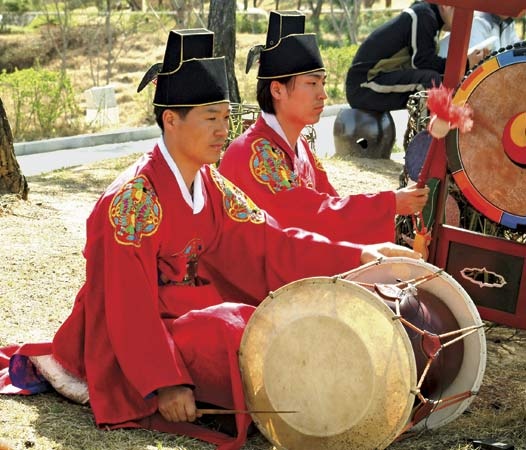drum
architecture
in architecture, any of the cylindrical stone blocks composing a column that is not a monolith. The term also denotes a circular or polygonal wall supporting a dome, cupola, or lantern (qq.v.).
container
in packaging, cylindrical container commonly made of metal or fibreboard. steel drums with capacities ranging up to 100 U.S. gallons (379 litres) have been produced since about 1903; the sizes less than 12 gallons (45 litres) are called pails. The most common drums are made of 18-gauge (0.048-inch, or 1.2-millimetre, thick) steel and contain 55 gallons (208 litres); they become the property of the buyer of the contents. Heavier drums or those made of more expensive metals (aluminum, Monel, stainless steel, or nickel) commonly remain the property of the vendor. Provided with a protective interior coating, in most cases a synthetic resin, steel drums or pails can be used for packaging most liquid and solid substances, and they have largely replaced wooden barrels and kegs.
Fibreboard drums have been produced since early in the 20th century. They are made with ends of steel or paperboard in sizes up to 75 gallons and are cheap and lightweight. They are commonly resin-coated or lined with loose plastic bags for packaging solid materials.
fish
also called croaker,
in biology, any of about 275 species of fishes of the family Sciaenidae (order Perciformes); drums are carnivorous, generally bottom-dwelling fishes. Most are marine, found along warm and tropical seashores. A number inhabit temperate or fresh waters. Most are noisemakers and can “vocalize” by moving strong muscles attached to the air bladder, which acts as a resonating chamber, amplifying the sounds.
Drums have two dorsal fins and are usually silvery in colour. The weakfishes, seatrouts, and squeteagues (Cynoscion) have large mouths, jutting lower jaws, and canine teeth, but most drums have underslung lower jaws and small teeth. Some have whiskerlike barbels on the chin. The largest member of the family, weighing up to 100 kg (225 pounds), is the totuava (Totoaba macdonaldi) of the Gulf of California; most other species are much smaller.
Although the name croaker, or drum, is applied to the family as a whole and to certain species, some of the sciaenids are known by such names as corbina, whiting, weakfish, and channel bass. Many members of the family are food or game fishes. Among the better-known species are the channel bass, or red drum (Sciaenops ocellatus), a large, reddish species of the western Atlantic Ocean; the white seabass (Atractoscion nobilis) of the eastern Pacific; the freshwater drum (Aplodinotus grunniens), a silvery, lake-and-river fish of the Americas; the kingfish, or whiting (Menticirrhus saxatilis), of the Atlantic, notable among drums in that it lacks an air bladder; and the sea drum, or black drum (Pogonias cromis), a gray or coppery red, western Atlantic fish.
musical instrument
 musical instrument, the sound of which is produced by the vibration of a stretched membrane (it is thus classified as a membranophone within the larger category of percussion instruments (percussion instrument)). Basically, a drum is either a tube or a bowl of wood, metal, or pottery (the “shell”) covered at one or both ends by a membrane (the “head”), which is usually struck by a hand or stick. Friction drums (friction drum), a class apart, are sounded by rubbing.
musical instrument, the sound of which is produced by the vibration of a stretched membrane (it is thus classified as a membranophone within the larger category of percussion instruments (percussion instrument)). Basically, a drum is either a tube or a bowl of wood, metal, or pottery (the “shell”) covered at one or both ends by a membrane (the “head”), which is usually struck by a hand or stick. Friction drums (friction drum), a class apart, are sounded by rubbing.(To hear audio clips of a variety of drums, see bass drum, changgo, snare drum, tambourine, tenor drum, and timpani.)
Tubular drums assume many shapes (goblet, hourglass, barrel, etc.) and are considered shallow if the height is less than the diameter. If the drum is so shallow that the shell cannot act as a resonator for the sound (as in a tambourine), it is considered a frame drum.
 Drums appear with wide geographic distribution in archaeological excavations from Neolithic times onward; one excavated in Moravia is dated at 6000 BC. Early drums consisted of a section of hollowed tree trunk covered at one end with reptile or fish skin and were struck with the hands. Later, the skin was taken from hunted game or cattle, and sticks were used. The double-headed drum came later, as did pottery drums in various shapes. The heads were fastened by several methods, some still in use. The skin might be secured to single-headed drums by pegs, nails, glue, buttoning (through holes in the membrane), or neck lacing (wrapping a cord around the membrane overlap). Double-headed drums were often directly cord-tensioned (i.e., through holes in the skin). Modern European orchestral drums often combine two hoops pressing against each head (one rolled in the skin, the other outside) with indirect lacing (i.e., to the hoops).
Drums appear with wide geographic distribution in archaeological excavations from Neolithic times onward; one excavated in Moravia is dated at 6000 BC. Early drums consisted of a section of hollowed tree trunk covered at one end with reptile or fish skin and were struck with the hands. Later, the skin was taken from hunted game or cattle, and sticks were used. The double-headed drum came later, as did pottery drums in various shapes. The heads were fastened by several methods, some still in use. The skin might be secured to single-headed drums by pegs, nails, glue, buttoning (through holes in the membrane), or neck lacing (wrapping a cord around the membrane overlap). Double-headed drums were often directly cord-tensioned (i.e., through holes in the skin). Modern European orchestral drums often combine two hoops pressing against each head (one rolled in the skin, the other outside) with indirect lacing (i.e., to the hoops). Drums typically have conspicuous extramusical functions—civil, message transmitting, and, particularly, religious. Credited with magical powers, they are frequently held sacred. In many societies their manufacture involves ritual. In East Africa, offerings such as cattle are made to the royal kettledrums, which not only symbolize the king's power and status but also offer him supernatural protection.
Drums typically have conspicuous extramusical functions—civil, message transmitting, and, particularly, religious. Credited with magical powers, they are frequently held sacred. In many societies their manufacture involves ritual. In East Africa, offerings such as cattle are made to the royal kettledrums, which not only symbolize the king's power and status but also offer him supernatural protection. Giant frame drums were used in the temples of ancient Sumer, and Mesopotamian objects from about 3000 BC depict frame drums and small cylindrical drums played horizontally and vertically. Early Egyptian (art and architecture, Egyptian) artifacts (c. 4000 BC) show a drum with skins stretched by a network of thongs. A waisted, or hourglass, drum is seen on one of the Bharhut reliefs (Bharhut sculpture), the oldest Indian temple reliefs (2nd century BC). The modern Indian damaru is an hourglass-shaped clapper drum (clapper)—when it is twisted its heads are struck by the ends of one or two cords attached to the shell. Barrel and shallow-nailed drums are particularly associated with India and East Asia; notable are the taiko drums of Japan, made in various sizes and with nailed or rope-lashed heads.
Giant frame drums were used in the temples of ancient Sumer, and Mesopotamian objects from about 3000 BC depict frame drums and small cylindrical drums played horizontally and vertically. Early Egyptian (art and architecture, Egyptian) artifacts (c. 4000 BC) show a drum with skins stretched by a network of thongs. A waisted, or hourglass, drum is seen on one of the Bharhut reliefs (Bharhut sculpture), the oldest Indian temple reliefs (2nd century BC). The modern Indian damaru is an hourglass-shaped clapper drum (clapper)—when it is twisted its heads are struck by the ends of one or two cords attached to the shell. Barrel and shallow-nailed drums are particularly associated with India and East Asia; notable are the taiko drums of Japan, made in various sizes and with nailed or rope-lashed heads. Frame drums were played in the ancient Middle East (chiefly by women), Greece, and Rome and reached medieval Europe through Islamic culture. Their shape varies (round, octagonal, square, etc.), they may have one or two heads, and they may have attached jingles or snares. Possibly of different origin are the frame drums used in the magico-religious ceremonies of shamans (shamanism) (a priest or priestess who uses magic for the purpose of curing the sick, divining the hidden, and controlling events) in Central Asia, the Arctic regions, and North America. Double-headed frame drums with enclosed pellets (found in India and Tibet Autonomous Region of China) are known as rattle drums.
Frame drums were played in the ancient Middle East (chiefly by women), Greece, and Rome and reached medieval Europe through Islamic culture. Their shape varies (round, octagonal, square, etc.), they may have one or two heads, and they may have attached jingles or snares. Possibly of different origin are the frame drums used in the magico-religious ceremonies of shamans (shamanism) (a priest or priestess who uses magic for the purpose of curing the sick, divining the hidden, and controlling events) in Central Asia, the Arctic regions, and North America. Double-headed frame drums with enclosed pellets (found in India and Tibet Autonomous Region of China) are known as rattle drums.Shallow kettledrums (kettledrum) are first depicted about 600 AD in Persia. Larger kettledrums, mentioned with the smaller type in the 10th century, are not pictured alone until the 12th. Though originally of clay and cord braced, kettledrums were later made of metal (or sometimes wood). They spread with Islamic culture through Europe, Africa, and Asia.
Little is known about medieval European drums and drumming, the only evidence being pictures and written references; no medieval drums survive. Written percussion parts (in instruction books only) date from the 16th century, as drummers were expected to extemporize their parts. By the 13th century, three types of drum appear to have been established: the nakers (naker), small paired kettledrums; the tab, a small cylindrical drum, often with snares; and the tambourine. They apparently served only as time beaters and, except for the tambourine, were beaten with sticks. Only from about the 14th century were drums built to produce loud, carrying sounds, a result of the introduction of mercenary infantry troops, in whose regiments fifes (fife) were soon paired with drums. Large kettledrums were associated with royalty and nobility. They entered the orchestra as a purely musical instrument in the mid-17th century, the bass drum (derived from the long drums of Turkish Janissary troops) during the 18th century, and the military-derived snare drum (side drum) during the 19th.
 Drums figure prominently in the 21st century in numerous musical genres around the world. The word drum is sometimes used for nonmembrane struck instruments, such as steel drums (steel drum), bronze drums, and slit drums (slit drum) (made of hollowed wood).
Drums figure prominently in the 21st century in numerous musical genres around the world. The word drum is sometimes used for nonmembrane struck instruments, such as steel drums (steel drum), bronze drums, and slit drums (slit drum) (made of hollowed wood).- Pierce, George Washington
- Pierce, Jane
- Pierce, John Davis
- Pierce, John Robinson
- Pierce, Sarah
- Pierce, The Elder Egan
- Pierina Legnani
- Pierino Belli
- Pieris
- Pier Leone Ghezzi
- Pier Luigi Nervi
- Piero della Francesca
- Piero di Cosimo
- Piero di Cosimo de' Medici
- Piero di Lorenzo de' Medici
- Piero di Tommaso Soderini
- Pier Paolo Pasolini
- Pierre
- Pierre André de Suffren de Saint-Tropez
- Pierre-André Latreille
- Pierre-Antoine Berryer
- Pierre-Antoine, Comte Daru
- Pierre-Antoine Daru, Comte
- Pierre Attaignant
- Pierre-Auguste Renoir